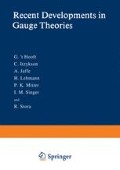Abstract
A properly called “naturalness” is imposed on gauge theories. It is an order-of-magnitude restriction that must hold at all energy scales μ. To construct models with complete naturalness for elementary particles one needs more types of confining gauge theories besides quantum chromodynamics. We propose a search program for models with improved naturalness and concentrate on the possibility that presently elementary fermions can be considered as composite. Chiral symmetry must then be responsible for the masslessness of these fermions. Thus we search for QCD-like models where chiral symmetry is not or only partly broken spontaneously. They are restricted by index relations that often cannot be satisfied by other than unphysical fractional indices. This difficulty made the author’s own search unsuccessful so far. As a by-product we find yet another reason why in ordinary QCD chiral symmetry must be broken spontaneously.
Access this chapter
Tax calculation will be finalised at checkout
Purchases are for personal use only
Preview
Unable to display preview. Download preview PDF.
References
P.A.M. Dirac, Nature 139 (1937) 323, Proc. Roy. Soc. A165 (1938) 199, and in: Current Trends in the Theory of Fields, (Tallahassee 1978) AIP Conf. Proc. No 48, Particles and Fields Subseries No 15, ed. by Lannuti and Williams, p. 169.
S. Dimopoulos and L. Susskind, Nucl. Phys. B155 (1979) 237.
M. Gell-Mann and M. Lévy, Nuovo Cim. 16 (1960) 705.
B.W. Lee, Chiral Dynamics, Gordon and Breach, New York, London, Paris 1972.
G. ‘t Hooft, Phys. Rev. Lett. 37 (1976) 8; Phys. Rev. D14 (1976) 3432.
S. Coleman, “The Uses of Instantons”, Erice Lectures 1977. R. Jackiw and C. Rebbi, Phys. Rev. Lett. 37 (1976) 172.
C. Callan, R. Dashen and D. Cross, Phys. Lett. 63B (1976) 334.
G. ‘t Hooft, Nucl. Phys. B72 (1974) 461.
T. Appelquist and J. Carazzone, Phys. Rev. D11 (1975) 2856.
A. Casher, Chiral Symmetry Breaking in Quark Confining Theories, Tel Aviv preprint TAUP 734 /79 (1979).
Author information
Authors and Affiliations
Editor information
Editors and Affiliations
Rights and permissions
Copyright information
© 1980 Plenum Press, New York
About this chapter
Cite this chapter
Hooft, G. (1980). Naturalness, Chiral Symmetry, and Spontaneous Chiral Symmetry Breaking. In: Hooft, G., et al. Recent Developments in Gauge Theories. NATO Advanced Study Institutes Series, vol 59. Springer, Boston, MA. https://doi.org/10.1007/978-1-4684-7571-5_9
Download citation
DOI: https://doi.org/10.1007/978-1-4684-7571-5_9
Publisher Name: Springer, Boston, MA
Print ISBN: 978-1-4684-7573-9
Online ISBN: 978-1-4684-7571-5
eBook Packages: Springer Book Archive

